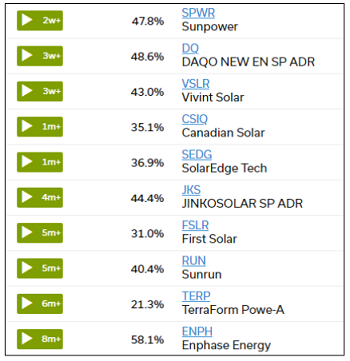For more than a decade, solar energy stocks have been on a “solarcoaster.” This has made the ride uncomfortable for solar investors. But big things are happening behind the scenes — and solar stocks could be gearing up for a multi-year bull run.
The “solarcoaster,” an industry nickname, is a boom-bust pattern created by government subsidies and supply gluts. In 2010, Germany was the largest solar panel market in the world. This was largely due to European subsidies and a political desire to embrace green energy.
But then, European solar subsidies were cut back due to a mini-financial crisis — for a while it looked as if Greece might crash out of the eurozone — and China became the new hotspot for subsidies and government-sponsored production. A supply glut of Chinese panels then caused solar stocks to plummet.
As the China supply glut finally eased, the Invesco Solar ETF (NYSE: TAN) bottomed out near the end of 2012, and has mostly moved sideways since then.
Behind the scenes, though, the solar industry has come to a tipping point. On the other side of this tipping point, the “solarcoaster” could be left behind — and investors could embrace solar stocks for a multi-year bull run as solar power demand goes vertical.
Why now? Because solar is finally competitive on the cost side. In November 2018, new research estimates from Lazard, the investment bank, showed that the cost of wind and solar power had fallen below the cost of existing coal-fired plants in many parts of the U.S.
In other words, we have already crossed the threshold where solar is cheaper than coal — and solar costs will continue to fall at a rapid rate. This should lead to a rapid acceleration of demand. (In terms of global electricity generation, solar’s share is in the low single digits. In 2017, solar’s estimated share was just 2%.)
Part of the reason solar’s global share is so low is because the price economics are tough. It’s a “chicken and egg” type problem: In terms of production and distribution networks, you need massive scale for an energy source to be cheap.
Once the price competition threshold is crossed, though, solar demand is likely to explode. This is due to a kind of waterfall effect where demand rises by multiple orders of magnitude as prices decline.
To give an example: If, say, a key solar component costs $100 per unit, demand might be “X.”
If that same component falls in price to $10 per unit — a 90% drop — demand could rise to 100X.
If it falls to $1 per unit, demand could then rise to 10,000X or even 100,000X.
That is a generic example, but the main idea is that a substantial fall in production cost can lead to demand increases that are orders of magnitude larger, creating a massive expansion of revenue and profits for the makers of solar components. As solar gets cheaper than coal, we are seeing that kind of math kick in.
Other supporting technologies are also changing the game for solar. Take battery storage, machine learning, and algorithms for example.
Thanks to the global electric vehicle (EV) race, tens of billions of dollars are being poured into next-generation improvements for battery storage technology. As battery technology gets better and cheaper, the economics improve for storing surplus energy in local battery systems.
Combined with machine learning and algorithms that live in the cloud, this is leading to the rise of “smart” solar systems that homeowners and small businesses can use without lifting a finger.
A “smart” solar system will use algorithms to manage the energy created by the local solar array for your home or business.
Algorithms will decide whether to send power to the building for immediate use; whether to top off local battery storage for usage later on; or whether to send energy back to the grid and collect a credit.
The cost of these “smart” solar systems will fall rapidly as more people buy them. Utilities will embrace these systems, too — getting into the installation and maintenance side — to offset declining revenues from the traditional grid. As the panels, the batteries, and the hardware all get cheaper via scale-based unit economics, going solar will become a no-brainer. This is how demand goes vertical.
This process will also be accelerated by government mandates, like the California law that requires every newly built home to have a solar system after 2020.
In the United States, there is also a significant chance that “Green New Deal” legislation will pass in the next few years. If this happens, solar will be a huge beneficiary — though solar already has so much momentum on the economics side, it probably won’t need it to thrive.
Below is a list of solar names via TAN, the Invesco Solar ETF. They are all in the green zone with medium to high levels of volatility, befitting their status as growth stocks.
 |
As mentioned, the “solarcoaster” of subsidies and supply gluts has made solar a wild ride in recent years. But for all of the churn on the surface, big things have been happening behind the scenes.
As the supply-and-demand economics of solar reach a tipping point — with solar now cheaper than coal in many places, and costs still falling as supportive technologies come online — solar stocks could be in the early stages of a multi-year bull run. You can track the progress and trend status of TAN and various solar names in TradeStops.





